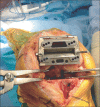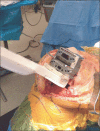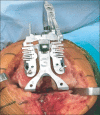Gap balancing vs. measured resection technique in total knee arthroplasty
- PMID: 24605183
- PMCID: PMC3942594
- DOI: 10.4055/cios.2014.6.1.1
Gap balancing vs. measured resection technique in total knee arthroplasty
Abstract
A goal of total knee arthroplasty is to obtain symmetric and balanced flexion and extension gaps. Controversy exists regarding the best surgical technique to utilize to obtain gap balance. Some favor the use of a measured resection technique in which bone landmarks, such as the transepicondylar, the anterior-posterior, or the posterior condylar axes are used to determine proper femoral component rotation and subsequent gap balance. Others favor a gap balancing technique in which the femoral component is positioned parallel to the resected proximal tibia with each collateral ligament equally tensioned to obtain a rectangular flexion gap. Two scientific studies have been performed comparing the two surgical techniques. The first utilized computer navigation and demonstrated a balanced and rectangular flexion gap was obtained much more frequently with use of a gap balanced technique. The second utilized in vivo video fluoroscopy and demonstrated a much high incidence of femoral condylar lift-off (instability) when a measured resection technique was used. In summary, the authors believe gap balancing techniques provide superior gap balance and function following total knee arthroplasty.
Keywords: Gap balancing; Measured resection; Total knee arthroplasty technique.
Conflict of interest statement
No potential conflict of interest relevant to this article was reported.
Figures









References
-
- Laskin RS. Flexion space configuration in total knee arthroplasty. J Arthroplasty. 1995;10(5):657–660. - PubMed
-
- Scuderi GR, Komistek RD, Dennis DA, Insall JN. The impact of femoral component rotational alignment on condylar lift-off. Clin Orthop Relat Res. 2003;(410):148–154. - PubMed
-
- Berger RA, Crossett LS, Jacobs JJ, Rubash HE. Malrotation causing patellofemoral complications after total knee arthroplasty. Clin Orthop Relat Res. 1998;(356):144–153. - PubMed
-
- Incavo SJ, Wild JJ, Coughlin KM, Beynnon BD. Early revision for component malrotation in total knee arthroplasty. Clin Orthop Relat Res. 2007;458:131–136. - PubMed
Publication types
MeSH terms
LinkOut - more resources
Full Text Sources
Other Literature Sources
Medical
Miscellaneous

